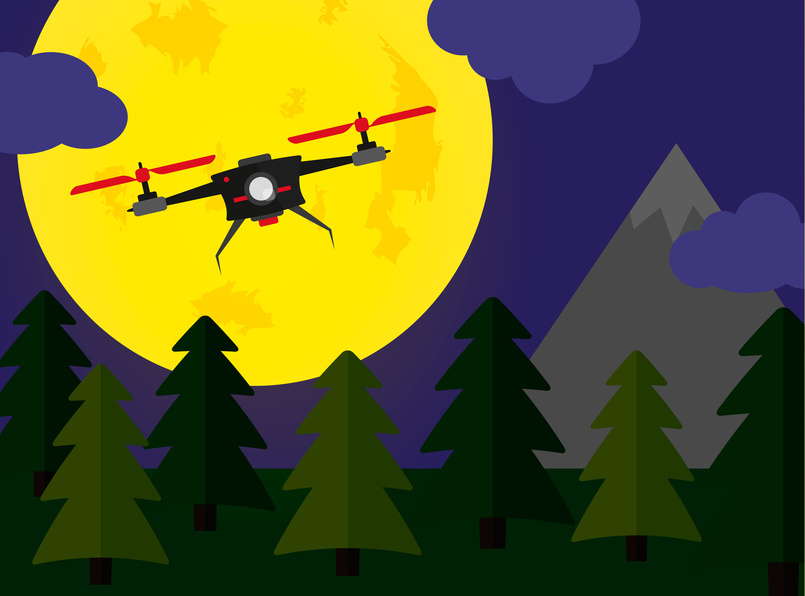Drones are on the rise: What are the privacy concerns?

Flying drone night forest scene with fullmoon vector flat illustration
I came across an article today about the Apple Store now selling drones. These devices are more commonly used by individuals, as well as from private sector and public sector entities although under each scenario, the privacy issues are obviously quite different.
Personal drone
Recent stories about unfriendly neighbours and drones have been circulating. On the privacy front, the concern has to do with being watched or under surveillance by a drone user neighbour, either on a continuing basis, or in private settings (i.e. a drone could be flying nearby the upper level window of a house).
In Quebec, the right to privacy is governed by the Civil Code of Quebec and the Quebec Charter (which Charter also applies to private sector entities). Article 36 (4) of the CCQ provides that it is considered as an invasion of someones’ privacy to be “keeping his private life under observation by any means”. Being monitored by a drone could be considered, at least in some situations, illegal under this provision.
In addition, article 36 (5) of the CCQ provides that it is considered as an invasion of someones’ privacy to be: “using his name, image, likeness or voice for a purpose other than the legitimate information of the public”. The language “other than the legitimate information of the public” should be interpreted to mean the right to freedom of expression, freedom of press and the public’s right to information. “Posting” a picture online is considered “publishing” the information. This means that even if a neighbour was legitimately, using his drone, recording someone, he could not publish or post the recorded information (without consent) unless the information was considered of “public interest”.
Private sector drone
Drones are also on the rise with private sector businesses. This triggers a different set of privacy concerns (depending on the type of personal information that these drones may be collecting and sharing, etc.). In Canada, organizations using drones would have to comply with applicable data protection laws (PIPEDA and substantially similar provincial laws from B.C., Alberta and Quebec) and disclose their privacy practices if these drones will be collecting, using or sharing personal information from their employees or customers.
Public sector drone
Public sector entities may be interested in using drones to prevent, detect or repress crime. There was a recent story about residents of a small town quite concerned about being monitored by drones.
In this type of situation, the privacy concern relates to having citizens recorded throughout the day, while in public (with or without their knowledge). Before conducting this type of monitoring, there should be clear guidelines to establish how long the recordings may be kept, especially if they are not used in an ongoing investigation.
When public sector entities are looking to conduct any form if surveillance (by drones or other methods), the consultations and guidelines that have been prepared and developed by some of the privacy commissioners on the use of CCTV cameras in public places can probably be useful. I am referring to the Guidelines for the Use of Video Surveillance of Public Places by Police and Law Enforcement Authorities issued by the Office of the Privacy Commissioner of Canada, the Alberta Public Surveillance Systems Guidelines, the British Columbia Public Surveillance System Privacy Guidelines, the Ontario Guidelines for Using Video Surveillance Cameras in Public Places, as well as the Quebec Rules for Use of Surveillance Cameras With Recording in Public Places by Public Bodies. Saskatchewan, Newfoundland and Labrador have also adopted similar Guidelines for Video Surveillance by Public Bodies.
In Quebec, the minimum rules which apply to the use of surveillance cameras (which may be relevant or for any form of public sector surveillance, either by drones or through other methods) can be summarized as follows:
- A study of the risks and dangers as well as a crime survey, in cooperation with insurers or the police if need be, should be carried out before using the surveillance tools.
- Alternatives to the use of such surveillance tools, less invasive of privacy, should be examined. If required, such devices should be used for a limited time on limited occasions (public festivities, particular events, period of the year, hours of the day, etc.).
- The public targeted by such surveillance should be informed by any appropriate notice: information and the name, address and telephone number of the owner or user of the equipment should be provided, on a sign for instance.
- The equipment selected should only keep the necessary information, for instance: if these devices operate under someone’s immediate supervision, this person should only record pictures in case of an offence. In cases where continuous recording is required, the material should be kept only for a limited period.
- Surveillance cameras should never be aimed at points like: house windows, showers, bathrooms, dressing rooms, etc. Persons assigned to the operation of such devices should be well aware of the rules designed to protect privacy.
- The rights of access and correction should be recognized to any person targeted by the recordings.
Moreover, it would need to be assessed whether the surveillance drones are having the deterrent effect hoped for. Any drone surveillance initiative would probably call for an assessment of security needs against the right to privacy.
This content has been updated on September 1, 2015 at 22 h 17 min.